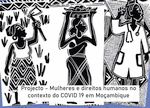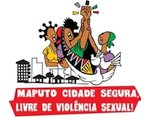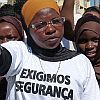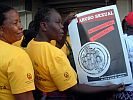Persistence of Inequality: When Will
Women Be Able To Decide For Themselves?
Opinion
Misete Getessemane Cossa
For about four weeks in October 2007 I participated in research in Zambezia province, in Quelimane town and in the districts of Morrumbala and Mocuba1. During my stay in the province various aspects caught my eye – for example, the faces of women and children, images that reflected in particular a landscape of poverty, scarred by the uncertainty of life and the morsel assigned to them. But also polygamy, the banality of domestic violence, the high level of sexually transmitted diseases and HIV/AIDS among women and their weak power of decision in their marital lives. These are the issues I wish to address, with no other intent than to share dilemmas and launch challenges.
In the small towns I visited the number of people with a regular income is minimal, often predominantly teachers, one or other nurse, and market vendors. It is this later group of individuals that attracts mainly girls who, with primary education and little possibility of continuing their studies, but also by “destiny”, see marriage as the ultimate purpose of their lives. These girls, the outcome of an education that provides no professional skills, do not consider subsistence agriculture as an income generating activity. Many of them see the informal market as a more honourable and prestigious activity. And money circulates most in this commercial circuit, making it more attractive.
This is the universe where women are considered to be responsible for the high incidence of sexually transmitted diseases, proof of their sins. It is said that girls have been acquiring other habits outside the home and that new clothes such as tight trousers, short skirts etc. have resulted in their being out of control. They, the men, were unanimous in stating that they are the main victims of women.
If the scenario is hazy in small towns, in a more rural environment the justifications take on other aspects, but nevertheless those responsible are women. From both informal conversations and through the research, I was able to see that the framework in which the pandemic of the century is usually described, is rejected here. For example, they say that the constant deaths attributed to HIV are associated, metaphorically, with Mbepo, a big wind in the Sena language. The Mbepo is a destructive wind like a hurricane. They say that the disease is linked to Mbepo because women, or rather girls, have too many abortions and this leads them to spread deadly diseases among men and women. This view of impunity fits what Douglas (1992) says “is not part of the classification and/or organization of a specific cultural world, or that which is on the border or at the edge of this system, commonly seen as threatening and thus impure, dirty”.
In short, despite some familiarity with the topic of gender relations in the country, I was shocked to find the constant assertion that women were responsible for the diseases/misfortune that afflict society, even though the arguments and justifications differ slightly from one place to another. So, in keeping with their secondary role, negative aspects are also always symbolically linked to women.
This issue reminds me of S. Ortner (2006) when she says that women are associated with nature and so they are considered dangerous and unpredictable, something that cannot be controlled. In support of this assertion, the author says that this is because, in men’s eyes the fact that a woman produces milk, that she menstruates, is unequivocal proof of her “animal likeness”. A man, on the contrary, is associated with culture, something subject to control, rationality, the predictable. But a woman, by nature, is irrational and unpredictable.
This absence of men’s culpability for the sexually transmitted diseases that affect families, such as the HIV/AIDS pandemic, also shows the prevalence of patriarchal power. Nowadays, when defence of an egalitarian society is part of the official discourse and proclaimed publicly, these aspects must be taken seriously as they do not contribute to the development of the same.
Another issue, also related to this secondary, subordinate role of women, is their weak, marital negotiating power. I saw that women cannot decide how many children they wish to have, when they will have them, when they wish to have sexual relations with their partner and when not. In other words, to a greater or lesser degree, when it comes to the specific negotiating capacity of each woman, she is denied control over her own body. One explanation for this is that a woman has historically been regarded as an object, the property of a man (father, husband, boss…), and her rights as a person and a citizen are secondary. As she is regarded as an object, the woman’s desire is not respected. This is evident, for example, when a husband refuses to use a condom, to have an HIV test, or when he prevents his wife from practicing family planning.
The female body is used to justify social inequalities; being female is associated with the body and her field of action ends up being reproduction. Masculinity is associated with the mind, and men’s field of action is knowledge and wisdom. Along these lines, in his work “Male Domination” Bourdieu (1999) analyzes control over the body and how this control is manifested in power and gender inequalities. He notes that male domination of women occurs because women are educated to interpret the world according to schemes and categories that are part of male thinking. He also notes that women’s inferiority is present in our own way of thinking and acting. The author points out that male domination over women is supported by symbolic violence that is invisible to its victims, implying that the dominated do not understand this domination relationship, because they think it is something natural and legitimate.
We cannot forget that these women, in addition to reflecting some of the aspects that characterize our patriarchal societies, are a model for young women. By maintaining the current status quo many of them will probably grow up in total ignorance of their human rights. They will not know that under the laws of their country, every woman has the right to decide how many children she would like to have, when to have them, and what kind of spacing. They will never be educated to enjoy the right to control their sexual behaviour as they wish, without fear or shame.
This experience was something totally new for me, but it reinforces my position on defending women’s human rights; it leads me to defend the need for more commitment to the fight for equality. There is an urgent need for correct, feasible and profound policies.
- Research on forms of family organisation and domestic violence, led by WLSA Mozambique, with primary school teachers, peasants and market vendors the target group.
References:
BOURDIEU, Pierre (1999). A Dominação Masculina. Rio de Janeiro: Bertrand.
DOUGLAS, Mary (1992). Pureza e perigo. Lisboa: Edições 70.
ORTNER, Sherry (2006). “Entonces, ¿Es la mujer al hombre lo que la naturaleza a la cultura?”, Revista de Antropología Iberoamerica (1) 1. pp. 21-21
* * *







 Information in English
Information in English



















